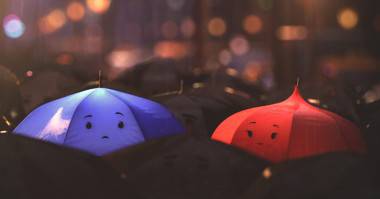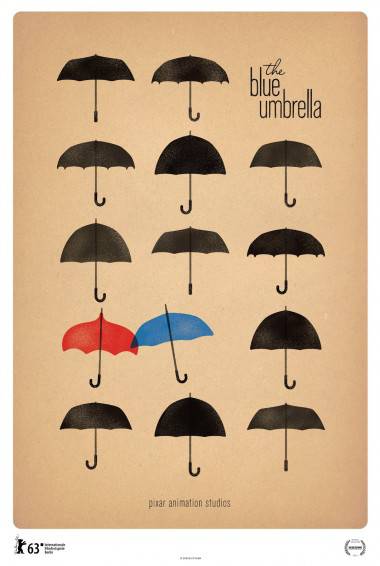Pixar’s The Blue Umbrella: An interview with Saschka Unseld
The Blue Umbrella is the new short from PIXAR. The story follows blue, happy and full of life as he and his fellow umbrellas come to life in the rain in the busy city, when he spots red, love blossoms, but fate is against these two love struck characters, will luck and their city friends be enough to get the young sweethearts back together against all odds?
http://youtu.be/lVFNRrL79w0
On first impression many would believe the hyper realistic film was a combination of live footage and composting techniques, but no, in true Pixar tradition everything from the mailbox to rain itself is completed imagined and created by the talented powerhouse of the creative team at the California based animation studio.
The animation uses new techniques in photorealistic shooting, composting and shading, improving the breadth of knowledge of this pioneering studio.
Directed and conceived by Saschka Unseld who has worked in cinematography and staging on films such as Brave and Toy Story 3. Skwigly was able to catch up with him at the recent Stuttgart international film festival, and took the opportunity to discuss his new film as well as his relationship with animation.
Can you explain how you came up with the idea for Blue Umbrella?
I found the idea on the streets, I was living in San Francisco and it was a rainy day and I was walking through the city and suddenly I saw something lying on the side of the street, it was an umbrella it was a completely broken umbrella that someone had thrown away and it was lying there completely depressed and broken. I stopped because it looked unbelievably sad and no one cared, people were just walking by and I realised I was feeling deeply sad for this umbrella that was just an object, but there was an emotional attachment there and that’s just something I remembered this emotional connection to this umbrella that was by himself, all alone and that lead me to the idea of telling the story of what happened to this umbrella and maybe there could be a way of getting to a happy ending.
The film is quite hyper realistic can you tell us why you chose to create the film in this way?
At one point when I worked on this story I had the idea that not only the umbrellas would come to life when it rained but the whole city. When I rained everything would come alive and be happy about the rain, and I had done a test where I thought it would be nice to have a music video were all these faces you see in the city would sing and so I shot a test on my iphone and pitched the idea to the people at PIXAR and showed them that test. I had literally shot a couple of things on my phone and animated the faces and so it was photo real as it was just easy to do and when I showed them the footage I realised that everyone got excited when these things come to life, these things that you know from walking around everyday suddenly become magical and that was the magic of it that you didn’t expect it. If they were cartoony and came to life you’d expect that, but not if a real city as you know it came to life then that’s magic. I wanted to keep that feeling, so that’s why we decided to keep it realistic.
How did the narrative develop over production?
There were a lot of changes, adjustments, improvements and small moments just to keep us emotionally with the umbrellas and so we would follow the story through, so we can empathise with the character. The biggest change we made was initially the city was just watching them, being happy and sad about them, depending on what happened to them, but at one point we realised they were probably friends, as they all come out when ever it rains, so they know each other and care about each other and if they care about each other the city would try and help blue, especially when blue falls into the traffic, and its really dangerous, they should try and help get him out of harms way and we came up with that idea during the production process, when we had some footage and looked through it we realised this doesn’t feel right, so that was probably the biggest change we added.
You mentioned before that city was meant to sing; can you explain why that changed?
Yeah, part of my pitch was that the city would become part of a Greek chorus in the beginning they would sing a song to celebrate the rain and as the umbrellas met, the song would change into a love song, and when the umbrella is lying in the side of the street it would change to a mourning song, with the Greek chorus in the background, which vocalises are feelings. Most of the way through production we thought this would work out, and at one point we finally had animation lip synced to the singing and we watched it together with John Lasseter and we realised that the city singing was such a astonishing thing it completely stole the show away from the main narrative, which was the love story between two umbrellas, every time you saw the umbrellas you wanted to see the city again. The core of the animation is the love story, so we had to tone down the city a bit, and that meant removing the city actually singing, we still have the same vocals really, its just it come out more metaphorical and not actually physically from the citys mouth.
How did you come into working in animation?
It was a sliding thing, in Germany when you graduate form normal high school you already have to pick two majors and two minors and I didn’t know what to do at the time, so I just picked whatever I liked, so my majors were math and art and my minors were computer science and philosophy, and I had no idea what to do with that it was just what I liked. Then I heard about the film academy here in Stuttgart which was well known for visual effects, so I thought that was a combination of arts and computer science and then I started studying there and I found out about animation, when Toy Story came out I thought this is even more amazing and so I followed what my heart told me would make me happy, so I started to discover I enjoyed creating animation, story telling and directing, it was a slow process over ten years but I just always followed what made me happy.
So what are you working on now?
Well now it’s a lot of going to conferences and showing The Blue Umbrella to people and answering their questions and talking about the production process, which is very exciting. I like talking to people and showing them the film, but I’m also working on a couple of ideas, helping out on a few films in the camera staging department, which I normally do on a day to day basis.
The Blue Umbrella will be screened before PIXARS new feature length Monsters University released on July 12, 2013.




